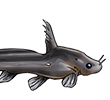Nico, LG, HL Jelks & T Tuten, 2009. Non-native suckermouth armored catfishes in Florida: Description of nest burrows and burrow colonies with assessment of shoreline conditions. Aquatic Nuisance Species Research Bulletin 9: 1–30.
Moderator note: Old link is dead. Here is a new functional link: https://emrrp.el.erdc.dren.mil/elpubs/p ... -v09-1.pdf
Pterygoplichthys burrows
- Silurus
- Posts: 12461
- Joined: 31 Dec 2002, 11:35
- I've donated: $12.00!
- My articles: 55
- My images: 896
- My catfish: 1
- My cats species list: 90 (i:1, k:0)
- Spotted: 428
- Location 1: Singapore
- Location 2: Moderator Emeritus
-
andywoolloo
- Posts: 2751
- Joined: 02 Dec 2007, 02:55
- I've donated: $100.00!
- My cats species list: 12 (i:0, k:0)
- My aquaria list: 1 (i:1)
- Location 2: Sanger, California
Re: Pterygoplichthys burrows
wow , figure 23 and figure 25.
I wonder how many eggs that is in #23? looks like 1,000!!
they are some strong catfish to borrow that deep.
Sp basically they conclude that maybe in high density with caves close together then maybe it will cause erosion and bank collapse? so basically they aren't hurting the banks right now?
Poor things, they didn't ask to come here and be dumped.
I wonder how many eggs that is in #23? looks like 1,000!!
they are some strong catfish to borrow that deep.
Sp basically they conclude that maybe in high density with caves close together then maybe it will cause erosion and bank collapse? so basically they aren't hurting the banks right now?
Poor things, they didn't ask to come here and be dumped.
- Suckermouth
- Posts: 1609
- Joined: 28 Nov 2003, 14:29
- My images: 17
- My cats species list: 22 (i:0, k:0)
- My aquaria list: 2 (i:0)
- My BLogs: 6 (i:0, p:165)
- Spotted: 14
- Location 1: USA
- Location 2: Washington, DC
Re: Pterygoplichthys burrows
Wow, the fact that they attach to manatees is actually pretty interesting.
I'll have to read over this when I have some free time.
I'll have to read over this when I have some free time.
- Milton Tan
Research Scientist @ Illinois Natural History Survey
Research Scientist @ Illinois Natural History Survey
- bekateen
- Posts: 9649
- Joined: 09 Sep 2014, 17:50
- I've donated: $40.00!
- My articles: 4
- My images: 143
- My cats species list: 146 (i:106, k:34)
- My aquaria list: 41 (i:18)
- My BLogs: 44 (i:154, p:2563)
- My Wishlist: 36
- Spotted: 184
- Location 1: USA, California, Stockton
- Location 2: USA, California, Stockton
- Contact:
Re: Pterygoplichthys burrows
And another: This is way out of date (not "current research" - publ. 2013 but only appeared in Google Scholar in 2019) but apparently it never made it into our forums when released.
Lienart, G.D.H., Rodiles-Hernández, R., & Capps, K.A. (2013). Nesting burrows and behavior of nonnative catfishes (Siluriformes: Loricariidae) in the Usumacinta-Grijalva watershed, Mexico. The Southwestern Naturalist, 58(2), 238-243.
https://doi.org/10.1894/0038-4909-58.2.238
Full text available here: https://www.researchgate.net/publicatio ... hed_Mexico
Lienart, G.D.H., Rodiles-Hernández, R., & Capps, K.A. (2013). Nesting burrows and behavior of nonnative catfishes (Siluriformes: Loricariidae) in the Usumacinta-Grijalva watershed, Mexico. The Southwestern Naturalist, 58(2), 238-243.
https://doi.org/10.1894/0038-4909-58.2.238
Full text available here: https://www.researchgate.net/publicatio ... hed_Mexico
ABSTRACT
Several species of (Siluriformes: Loricariidae) have been introduced around the world and are now invasive outside of their native range. In southern Mexico, Pterygoplichthys is quickly spreading and has become one of the dominant groups of fishes in many freshwater ecosystems. We describe the density and physical characteristics of large nesting burrows constructed in riverbanks and wetlands by nonnative Pterygoplichthys. Our study was conducted in the floodplains of the Chacamax River, one of the principal tributaries of the Usumacinta-Grijalva watershed. Burrows ranged from 30–140 cm in depth, 9–34 cm in width, and 4–26 cm in height. We counted an average of 1,573 burrows/km of waterway in a 14-km survey of the banks of the Chacamax River. Loricariids preferred to nest in banks with steep slopes, clay soils, and low coverage by roots.
RESUMEN
Varias especies introducidas de (Siluriformes: Loricariidae) están establecidas mundialmente como poblaciones invasoras fuera de su distribución geográfica original. En el sur de México el género Pterygoplichthys está invadiendo muchos sistemas dulceacuícolas de tal forma que actualmente es uno de los grupos dominantes de peces. Describimos la densidad y las características físicas de grandes madrigueras de anidación construidas en los taludes y las llanuras de inundación por Pterygoplichthys no nativo. Hicimos nuestro estudio en las llanuras de inundación del río Chacamax, uno de los principales afluentes de la cuenca del Usumacinta-Grijalva. Las dimensiones de las madrigueras fueron de 30–140 cm de profundidad, 9–34 cm de ancho y 4–26 cm de altura. Contamos un promedio de 1,573 madrigueras/km en un transecto de 14 km de los taludes a lo largo del rio Chacamax. Los loricáridos prefirieron anidar en riberas con pendientes pronunciadas y en suelos arcillosos con poca cobertura de raíces.
- Attachments
Find me on YouTube & Facebook: http://youtube.com/user/Bekateen1; https://www.facebook.com/Bekateen
Buying caves from https://plecocaves.com? Plecocaves sponsor Bekateen's Fishroom. Use coupon code bekateen for 15% off your order. Also, for you Swifties: Https://youtu.be/ZUKdhXL3NCw






